 Leading Blog | Posts by Category |
 Leading Blog | Posts by Category |
04.14.25

Challenges Facing Women Negotiators
HISTORICALLY, women have faced significant hurdles in employment negotiations. Here’s what we know about these barriers, plus strategies leaders can use to improve fairness in the workplace. The Barriers that Women Face In 2006, Carnegie Mellon University professor Linda Babcock and her colleagues published research showing that women tend to initiate negotiations, particularly salary negotiations, significantly less often than men do. The findings appeared to at least partially explain the enduring pay gap between men and women, which has remained frustratingly stable from 2002 to 2023. In a 2007 study, Harvard Kennedy School professor Hannah Riley Bowles, Babcock, and California State University professor Lei Lai found that evaluators penalized female job candidates who asked for higher pay, but not male candidates. Evaluators viewed women who asked for greater compensation less favorably than men who did so and were less interested in working with the women the future. Women appeared to face a catch-22: If they asked for more, they risked being viewed negatively. About 20 years have passed since research on gender differences in negotiation and tailored salary negotiation tips for women began to emerge. Have things changed? Yes and no. On the one hand, evidence suggests that many women are negotiating compensation more assertively. Unfortunately, however, these efforts have failed to move the needle on the gender pay gap. Women Do Ask In a 2024 study, researchers Laura Kray (University of California, Berkeley), Jessica Kennedy (Vanderbilt Business School), and Margaret Lee (UC Berkeley) surveyed 990 graduates of a top U.S. business school between 2015 and 2019 about whether they negotiated the salary of their first post-MBA job. The women reported negotiating salary more often than men: 54% of women said they did, while 44% of men did. And in a survey of nearly 2,000 B-school alumni, Kray and colleagues found that 64% of women and 59% of men reported negotiating for promotions or higher compensation. It seems that after the message on gender and salary negotiations came out around 2007, both men and women—but especially women—began to negotiate compensation more frequently. Nonetheless, recent female MBA graduates still earn less than their male peers: 88% of men’s earnings, a gap that widens to 63% after 10 years, report Kray and her team. If Salary Negotiations Aren’t the Problem, What Is? “Our research shows that women are willing to do their part to close the gender pay gap,” says Kennedy. “Unfortunately, negotiating well isn’t enough to close the gender pay gap. It’s not the source of the problem.” If differences in men and women negotiating salary isn’t the source of the gender pay gap, what is? “Economic studies show that the gender wage gap is explained more by differences in men’s and women’s career trajectories than by how men and women are paid for the same work,” according to Bowles. “We will make faster progress toward closing the gender wage gap by getting more women into high-paying jobs than by negotiating a little more money in lower-paid occupations.” 3 Strategies for Reducing Bias in Employment Negotiations It’s smart for all of us to proactively negotiate our compensation, benefits, and work roles throughout our careers. But workers can only do so much on their own. To promote fairness, organizational leaders can take the following steps. Institute more flexible, family-friendly policies and structures. This can include persuading people of all genders to take parental leave to creating more “substitutable work” that doesn’t require high earners to work grueling hours. Reduce bias in hiring and promotion. In their new book, Make Work Fair: Data-Driven Design for Real Results, Harvard Kennedy School professors Iris Bohnet and Siri Chilazi argue that fairness initiatives should be built into organization-wide systems. Setting clear salary ranges and standardizing job interviews and performance evaluations can make job processes fairer for all employees. Educate and mentor. Organizations can establish mentoring programs to help women, minorities, and others feel more comfortable negotiating assertively on their own behalf. They can also educate employees about common biases that negotiators face at the table and how they hold us all back. When people believe the “women don’t ask for more” narrative, they are less likely to support laws and policies aimed at reducing bias in negotiation, Kray and colleagues found. Spreading the word that women increasingly are negotiating as assertively as men could help build support for fairer policies. By recognizing gender inequality in negotiations as a shared problem, we can both lessen the burden on women and promote more productive negotiations. 
Posted by Michael McKinney at 11:52 AM
07.05.24

What is the Gouge?
NAVY SEALs talk about the Gouge. But what is it? It’s not a thing but mental readiness—a preparedness that is based on some foundational beliefs. It is a place you bring yourself and others to mentally. It is defined by Admiral and former Navy SEAL Bob Harward in The Gouge!, as “the contract we all have with humanity, sharing the best of everyone for the collective well-being of all. It was always intended to be information you could believe in, people you could trust, organizations you could rely on because it came from people who wanted the best for you, and therefore good for all.” What caught my attention was the subtitle of the book: How to Be Smarter Than the Situation You Are In. The Gouge is more than just good advice shared with others. It is a perspective that brings out the best in others. It is a decision-making tool that presents obstacles as choices. Harward explains: Each choice is filtered through the collective experience and wisdom of those participating and reinforced accountability to each other and to yourself, faith in one another, and inherent trust, which facilitates deliberate action. Once the choice is made, you’re committed and focused on making the right choice. To have Gouge, you must be a tuned-in person with the following fundamental beliefs: Mission First. People Always. We can make others better every day. As a leader, “you are a participant in human development. If we can take care of people and each other, the rest of it will come.” Looking out for others builds trust and confidence. The mission succeeds when people succeed. Purpose Defines You. Embrace It. It all comes down to purpose. Leaders reinforce and leverage purpose. “If Gouge is about the information that links -all of us together, our purpose is the bedrock on which Gouge is built. It determines who you are, reinforces your belief, and ultimately determines your success.” We Are All Accountable for Ourselves and Others Looking out for each other requires accountability at all levels. It must come from above and below. “Lack of accountability is a slippery slope that is hard to stop once it festers itself in any organization or team. Accountability and confrontation are aligned. If you’re going to avoid confrontation, you’ll never hold anyone accountable.” Constructive, forward-looking confrontation is a part of accountability. Anonymity kills accountability. You don’t have to own what you say. While social media can be used for good, it has created cultural accountability problems. “Tweeting. Posting on Facebook. All of those sites put a barrier between human connection, allowing people to refuse accountability for what they’re saying or doing.” The best leaders know how to effectively implement it to get the best results for their team so they can fulfill their purpose. During any confrontation, remember we are one community with a purpose. Faith In People Is My Religion Faith in each other builds community. “It is essential because if you don’t have faith in one another, there is no trust, no passing of information or guidance, and the whole system breaks down.” This faith is placed in the bond between two people, casting your dot with your fellow man in hopes of achieving a common goal. Never Quit, but Saying No Is Always an Option For Navy SEALS, quitting is a mortal sin. No matter the demands, never quit. But there are times when the best Gouge is to quit. Sometimes, saying no is “just an opportunity to say yes to something else.” Sometimes, saying no forces you to live up to your maximum potential. Great Leaders Share Gouge Empower and support others through Gouge. Show them through your actions. “By showing your people that you see them not as a way to accomplish a mission but as teammates working with you to accomplish a mission. Make sure everyone is armed with the best information so they can not only do the job but so they can sync it with their purpose.” What About Bad Gouge? When people are working at cross purposes, there is bad Gouge. When you find yourself in a new situation, you need to recalibrate. “You have to think to yourself: Is someone trying to sell me something? Does it benefit this person/company in any way if they influence my thinking one way or another? Does this person have credibility?” Many times, bad Gouge is simply being surrounded by the wrong people. Good Gouge only comes from relationships where everyone is on the same page and working toward the same goal. Identify Your Own Gouge To identify your Gouge, “think about the essential personal and professional information you want your employees, team, and children to know. Focus on empowering those around you instead of yourself, and watch how successful you become. Always look to better yourself and better those around you, and always be courageous enough to communicate it. The Gouge is very simple. It is information used to create a better outcome for all.” 
Posted by Michael McKinney at 06:07 PM
02.23.24

Empathy: The Top Leadership Skill for Today’s Work Environment
AS workplace cultures evolve, we must specifically prioritize the needs of each human being. An empathetic approach to organizational culture has been proven to have positive business outcomes. Recently, a large study ranked empathy as the most important leadership skill in the workplace. Empathy has been shown to drive positive business results and has numerous therapeutic effects on stressed employees. When leaders expressed empathy for their team, it increased a team’s innovation and engagement, improved customer service, and helped them balance their home and work life. British entrepreneur Sir Richard Branson said, “Understanding empathy, as well as the experiences of people from different areas of life, is a key skill for business leaders.” With similar conviction, Satya Nadella, CEO of Microsoft, said, “Empathy makes you a better innovator. ...It’s a quality my wife helped me begin to learn when our son was born with severe disabilities. It’s a quality that shapes our quest to meet unmet needs of customers. And…it helps us as a society move forward in creating new opportunities for all.” To further document empathy’s advantages at work, the Global Empathy Index, published in the Harvard Business Review, examined data from employee’s responses to questions ranging from a CEO’s approval ranking to their own happiness level in their job. Researchers found that empathic companies are the most profitable and are associated with increased employee earnings and gratification as well as customer satisfaction. The appeal of empathic leadership extends beyond conventional office environments. Former Navy SEAL commander Mark Divine trains athletes, SWAT teams, first responders, and aspiring SEALS to combine mental toughness with intuition and heart. Empathic leadership is not only for supersensitive types. It is also for tough people in any field. You can become an empathic leader whether you’re a new manager, a C-suite executive, or you’re simply leading by example in any job even if you don’t manage anyone. Because the need for empathy and human connection has increased in our chaotic world, the power of everyday empathic leadership has grown. To become a more empathetic leader, hone these key traits:
When an empathic leader, for example, sees a team member faltering, they don’t crank up the pressure to perform or use criticism to motivate. Nor do they lead with impatience, which only makes people freeze or panic. Instead, they begin with appreciation for the person’s contributions to the team. Then, in a caring tone, they address any difficulties they are encountering and explore strategies together to reach their goal. Approaching a team member with empathy rather than provocation doesn’t make leaders pushovers, weak, or unable to set boundaries. Rather, they incorporate strength and compassion to lead.  Sign up here for Dr. Orloff’s online webinar about empathetic healing techniques based on The Genius of Empathy on April 20, 2024, 11am-1pm PST. 
Posted by Michael McKinney at 08:41 AM
08.16.21

15 Attributes of Positively Energizing Leaders
WHEN YOU HEAR the term positive leadership, it is easy to get cynical and think it is all happy-talk and disconnected from reality. But it isn’t. In fact, it is about those attributes that energize us and help us to deal with reality in a productive way. In Positively Energizing Leadership, Professor of Management and Organizations at the Ross School of Business at the University of Michigan, Kim Cameron, says it is about “how to capitalize on an inherent tendency in all living systems to orient themselves toward light or life-giving positive energy. It is known as the heliotropic effect. It is a “concept adapted from a phenomenon typically ascribed to how plants respond to the sun’s rays.” Cameron applies it here to the social and organizational sciences. “The kind of positive energy that most accounts for flourishing in individuals and in organizations is called relational energy.” Relational energy is brought to you by virtuous actions like generosity, compassion, gratitude, trustworthiness, forgiveness, and kindness. Mandating that employees behave positively, think happy thoughts, or be cheerful when they are depressed, anxious, or experiencing emotional pain produces false positivity. It is inauthentic, disingenuous, dishonest, and untrustworthy. It denies reality, which is the opposite of virtuous responses in trying times. It is these virtuous responses that build the relational energy that moves an organization forward in good and bad times. It is real, and we naturally respond positively to them—the heliotropic effect. Importantly, these demonstrated behaviors “lead to the only kind of energy that does not deplete with use and does not require recovery time after it is expended. Whereas physical, emotional, and mental energy diminishes with use, relational energy elevates. There are 15 attributes associated with positively energizing leaders: 1. Help other people flourish without expecting a payback. Positive energizing is not transactional. “A quid pro quo is not expected.” They contribute for the benefit of others without concern for who gets the credit. 2. Express gratitude and humility. Humility makes possible to put the spotlight on others and expressing gratitude for their contribution early and often. Humility also means graciously accepting feedback. 3. Instill confidence and self-efficacy in others. They know how to build confidence in others by acknowledging their strengths. They assist when others fall short. They also create opportunities for others to be acknowledged for their successes. 4. Frequently smile. A smile is often overlooked, but it goes a long way. In repose, we sometimes look angry or sad. A leader should always be mindful of the emotion they are communicating. Put on a smile. 5. Forgive weaknesses. Cary Nieuwhof once wrote, “Be the type of friend that fixes a friend’s crown without telling them it’s crooked.” Positively energizing leaders forgive and turn mistakes and failures into learning experiences. 6. Are personal and know outside-of-work interests. Understanding that the whole person comes to work, positively energizing leaders invest the time to get to know the whole person – family, interests, and goals. “A study at the University of Kansas found that it takes about 50 hours of socializing to progress from an acquaintance to a ‘casual’ friend, an additional 40 hours to become a ‘real’ friend, and a total of 200 hours to become a close friend.” 7. Share plum assignments and recognize others’ involvement. Rather than keeping the best assignments for themselves, “they find ways to involve others, to help them find ways to succeed, and to be acknowledged. They are willing to share the limelight without abrogating their own responsibility to lead.” 8. Listen actively and empathically. They consciously do not dominate the conversation and share their ideas. They listen and ask questions giving others the opportunity to share. They respond compassionately when necessary. 9. Solve problems rather than create problems. They anticipate the needs of others and potential problems and respond rather than always reacting. “They take responsibility for generating results.” 10. Mostly see opportunities. They possess a realistic optimism. They find a way forward through problems rather than getting bogged down in the moment. They are hopeful. “They approach challenges and difficulties with a ‘yes, and’ rather than a ‘yeah, but.’” 11. Tend to inspire and provide meaning. They have clarity. They know why we are doing what we are doing and inspire others to see their part and impact in the bigger picture. “They elevate others’ views.” 12. Are trusting and trustworthy. They are trusted to do what they say they will do and behave in alignment with their stated values. They also build trust by being trusting. 13. Are genuine and authentic. Their positivity is genuine and not an act. It is derived from who they are. When appropriate, they share their personal challenges and mistakes to encourage others to move forward. 14. Expect very high performance standards. Never satisfied with good enough, they help other to exceed the basic requirements and help them achieve beyond what they thought possible. 15. Mobilize positive energizers who can motivate others. They seek out other positively oriented people and mobilize them to uplift others and create a positive work environment. “They marshal positive energizers to foster improvement and goal accomplishment. Few people possess all of these attributes, but everyone can develop them. In Cameron’s research, all 15 attributes contributed to positive outcomes, but the last 5 (11 through 15) were “especially powerful predictors of organizational success.” These findings highlight the fact that positively energizing leaders do not need to display superhuman attributes. They are individuals who simply display behaviors that we all admire: inspiring others, show integrity, and being genuine. They expect us to be better. And they involve others in accomplishing desired outcomes. As a result, the organizations they lead perform significantly better than industry averages. Cameron provides specific ideas on how to develop these attributes and examples of energizing leadership and its impact on organizational performance. When people are struggling or going through difficult times, putting on a happy face is not the answer. Instead, Cameron suggests that we “focus less on cheerfulness, positive thinking, and unbridled optimism” and emphasize “demonstrating virtuousness. Virtuous behaviors—including gratitude, humility, kindness, generosity, contribution, forgiveness, compassion, trust, and integrity—are heliotropic and lead to positive energy and thriving, especially in difficult times.”  
Posted by Michael McKinney at 10:10 AM
02.21.20

All You Have to Do Is Ask
IF WE ARE HONEST with ourselves, we know there are times we need help. We just don’t want to ask for it. We’re confident we can figure it out. In time. But here’s the thing. There’s nothing we are going through or trying to figure out that others haven’t blazed a trail for us already. We just need to ask. Wayne Baker says, “you never know what people know—or who they know—until you ask. Asking for help can mean the difference between success and failure.” In All You Have to Do Is Ask he identifies eight reasons why we don’t or won’t ask. As a result, we leave a lot of answers, solutions and resources on the table for no good reason. And here are eight no good reasons:
That last reason—the fear of seeming selfish—relates to the proverb that it’s better to give than receive. That’s true. We want to be givers, but that doesn’t make receiving a bad thing. “There’s no giving without receiving, and there is no receiving without giving. And it’s the request that starts the wheel turning.” Baker offers a quick scientific assessment in the book (or online) to determine what style of asking/giving you tend to choose. And it is a choice. Are you an overgenerous giver, a selfish taker, a lone wolf, or a giver-requester? These types all represent “choices you can make about how you want to operate in the world.”
The place to begin is to understand and articulate your needs. Know what you are trying to accomplish and when. With that in mind, formulate a SMART request. That is a Specific (“a specific request yields more help than a vague one”), Meaningful (“Why is the request important to you?”), Action-oriented (What action do you want to be taken?), Realistic (it may be a serious long-shot, but within the realm of possibility), and Time-bound (“every request should have a due date”) request. After you have formulated your request, you need to figure out who to ask. Who knows what you need to know or who you need to talk to? Go outside your usual circle of contacts. Then ASK. And a good piece of advice: “Rejection is just an opinion. And opinions change. In other words, you can find ways to turn a no into a yes.” Baker offers much more specific advice and examples throughout but let me mention two tools that have proven effective that Wayne Baker and Adam Grant have developed. The first is Reciprocity Rings. Reciprocity Rings A Reciprocity Ring is a group activity consisting of 20 or so people that gather together and share a request with the group one by one. “Other members of the group pause to consider how they could help: Do I have the resource the person needs? Of not, do I know someone in my network who might be able to help? Because it’s much easier for people to make a request when they know that everyone must make one, every participant is required to make a request; asking is the ‘ticket of admission’ to the Reciprocity Ring.” Reciprocity Rings have been implemented successfully at Google, General Motors, IBM, Citigroup, UPS, and others. Givitas Givitas is a collaborative technology platform that provides a safe platform for requesting, giving, and receiving help across boundaries across a vast scale. It helps you share widely beyond the usual suspects. Platforms like Givitas allow people to get what they need without having to repeatedly tap all the same experts or all the usual go-to people because requests are decentralized and broadcast across the vast network. Thanks For Asking We’ve all asked for help only to be rebuffed or made to look stupid. Of course, we recognize and reward people for giving help, but we don’t typically reward people for asking for help. “How our request is received, how we are treated, and how the help is granted determines whether we get discouraged, or encouraged to make asking a personal practice.” With both organizational and individual success at stake, we need to rethink our responses to asking. “Recognizing, appreciating, and rewarding those who ask is as critical as doing the same for those who answer.” Baker shares informal and formal ways we can as individuals and organizations recognize, reward, and encourage asking. Asking improves individual performance and effectiveness. All You Have to Do Is Ask will change your appreciation of asking. It certainly changed my view. 
Posted by Michael McKinney at 05:34 PM
01.17.20

The Power of Bad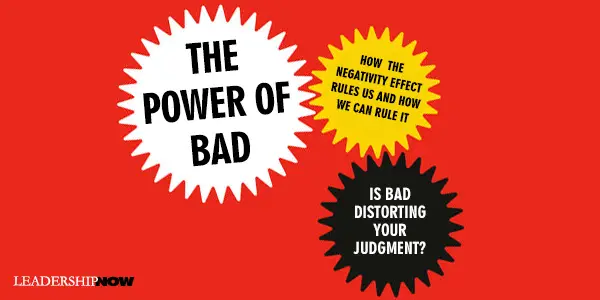
BAD gets into our head and it stays there leaving very little room for the good in our lives. We tend to focus on the bad, even in the face of a lot of positive things. Our brains are wired that way. It’s the negativity effect: the universal tendency for negative emotions and events to affect us more strongly than positive ones. John Tierney and Roy Baumeister (the first researcher to identify the negativity effect) describe the phenomenon well in The Power of Bad: We’re devastated by a word of criticism but unmoved by a shower of praise. We see the hostile face in the crowd and miss all the friendly smiles. The negativity effect sounds depressing—and it often is—but it doesn’t have to be the end of the story. Bad is stronger, but good can prevail if we know what we’re up against. Because of this, we have learned that it takes about four good things to overcome just one bad experience. It’s a rule of thumb, but it is useful to keep in mind when dealing with others and to understand our impact on those around us. “Being able to hold your tongue rather than say something nasty or spiteful will do much more for your relationship than a good word or deed.” Good relationships are more about what you don’t do. “Avoiding bad is far more important than doing good.” You don’t get much credit for going the extra mile, but you pay a big penalty for doing something bad. So how do we eliminate or a least minimize the bad? The negative? Not surprisingly, the more insecure you are, the more likely you are to act and think negatively. And our negative thoughts become a self-fulfilling prophecy dragging us deeper into the cynicism and doubt that undermines us. Negative thinking makes us small. Positive people “literally see a bigger picture. Their eyes sweep a wider field of vision instead of just focusing on what’s straight ahead, as they do when prompted with negative stimuli. Positive emotions broaden your perspective and enable you to build skills that help you flourish both personally and professionally.” We look for bad things. “Even when things are going your way, the amygdala keeps looking for the cloud behind the silver lining.” We create fears. They can become runaway trains that cripple us. When we do discover a fear, we need to put it in perspective. How important is it really? Rationally override the feeling by talking about it. How would you advise someone else in the same situation? Know what triggers your fear and calm yourself with coping statements. And breath. “A deep breath is a signal to the body that we’re safe.” Depressed people suffer from extreme negativity bias in the way they see themselves, the world, and the future. Depressed people focus relentlessly on their weaknesses and failures, ignoring their strengths and diminishing their successes as flukes. They interpret one setback as a fatal mistake and imagine it, leading to the worst possible outcome. Researcher Bethany Teachman says, “People with phobias want to avoid panic attacks, but that’s not the right goal to start with. The first goal is to stop caring whether or not you have a panic attack. A panic attack is uncomfortable but not dangerous. It’s a false alarm—a fear of fear. Once you make the decision to tolerate it, you get a sense of mastery, and eventually, the fear loses its power over you, and the panic attacks don’t come anymore.” What should we do when delivering bad news? Many think that the best thing to do is to deliver it gradually or after some good news, but research says most people would rather have the bad news first and straight. The criticism sandwich doesn’t really do what we hope it would because the “brain doesn’t logically process threatening information.” For praise or other good news to make a lasting impact, the brain must transfer it from the short-term working memory into long-term memory. This process gets disrupted when good news is followed by something negative. The brain uses so much energy to focus on the new threat that the previous pleasantness gets lost because of an effect called retroactive interference. If you have to deliver bad news or criticism, the authors recommend that first, consider your objective. Are you simply delivering bad news, or are you trying to get someone to change? When people heard first about their bad traits and then their good ones, they ended the experiments in a better mood, but they were also less inclined to do work to correct their bad qualities. The ones who heard the bad traits last were more worried but also eager for self-improvement. It’s not easy to motivate without demoralizing, but you can compromise by concentrating on the good feedback toward the end while also finishing up with a clear reminder of what's wrong and how to fix it. From there, the authors advise us, among other things, to ask questions, and then once we’ve gotten the criticism across, use the power of bad to your advantage. (Good insights on delivering criticism begin on page 99.) Hell motivates us more than heaven. Penalties for mistakes make us learn much more quickly than rewards. The fear of looking fat motivates us more to lose weight than the hope of looking slim. The advantage of penalties is that they are “so powerful that you often don’t have to use them. Rewards have to be doled out continually, but the mere threat of a penalty can make a lasting impact.” When bad things do happen to us, our response becomes the key issue. While many people experience a traumatic event in their lives, most—four out of five—trauma victims did not suffer from post-traumatic stress disorder (PTSD) afterward. “Instead of being permanently scarred, they underwent post-traumatic growth (PTG). Studies have found that more than 60 percent (sometimes 90 percent) of trauma victims undergo post-traumatic growth, including ones who initially showed symptoms of PTSD. Our response to life is everything. “The growth comes not from the trauma but from the way that people respond to it to become kinder, stronger, and more mindful of the joys in life.” When things do go wrong—and they will—force yourself to see it from another perspective. “People of all ages can counter the power of bad by consciously rewriting their narratives, focusing on their blessings, and savoring the good moments of their lives.” In 1841 Scottish journalist Charles Mackay published Extraordinary Popular Delusions and the Madness of Crowds. In it, he writes, “Men, it has been well said, think in herds. It will be seen that they go mad in herds, while they only recover their senses slowly, and one by one.” It’s up to each of us to see that good prevails. 
Posted by Michael McKinney at 07:34 AM
11.22.19

Empathy-Driven Leadership: How to Be Compassionately Competitive in a For-Profit World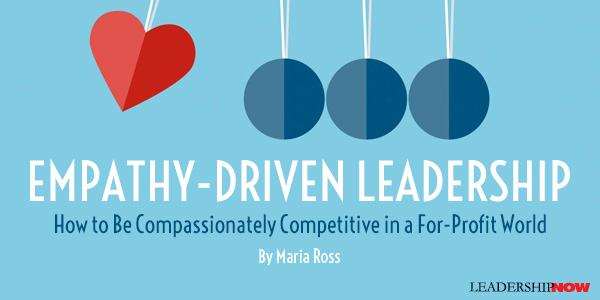
EMPATHY? Isn’t that for directors of nonprofits and starry-eyed Millennial entrepreneurs with idealistic dreams? What good is empathy in an uber-competitive, saturated marketplace where leaders need to capitalize on every opportunity to stand out? The Empathy Edge definitively answers these questions showing how for-profit leaders can use empathy to gain the upper hand. Contrary to popular belief, compassion and empathy are actually huge assets in the business world. What if leaders could shift the cultural mindset around what gives businesses a competitive advantage and recognize the benefits of being more human? Not only would they build smarter businesses, connect more deeply with their customers, and become stronger leaders, but also maybe, just maybe, our world could become a little bit better. This is an interesting proposition. Leaders are in a position to influence how we think about the relationship between empathy and industry. Still, a sea change like this is hard-won. So, what’s in it for the leaders themselves? Benefits of Empathetic Leadership When you start to explore the benefits of empathetic leadership on a deeper level, it becomes difficult to see empathy as anything other than essential for competent leadership. Highly empathetic people (or HEP’s) recognize the pain and suffering of others as a problem in need of a solution. This is the foundation of every good business model. Further, without empathy, leaders can’t build a team, inspire followers, or elicit loyalty. Among the benefits that come to empathetic leaders, whether they are entrepreneurs or c-suite executives, are the following:
The benefits of empathy for individual leaders are many, and this list likely only scratches the surface. But it’s clear that empathy is a core leadership skill. Now you may be wondering what it takes to be (or become) an empathetic leader. You may recognize empathy as an innate human trait, and as with all human traits, there is a spectrum of strengths and weaknesses. Some of us are naturally “gifted” when it comes to being able to relate to others’ experiences, while others are naturally lower on the empathy scale. The good news is—no matter where you find your natural tendency—empathy, like other leadership skills, is something we can learn, cultivate, develop, and teach to others. In the book, you will find seven simple ways to train yourself to lead more empathetically. Here are four of the most actionable steps you can take: 1. Practice Presence. When you feel constantly scattered and spread too thin, it may seem like you can’t find even five minutes in your busy workday to take a break. But if you can’t ground yourself, how can you expect to be able to consider others’ perspectives? When you’re present with yourself, you’ll have a fighting chance of being present with others. Create space for a daily practice of meditation or simply sitting in silence. Even a few minutes will help. 2. Listen More, Stay Humble. Empathy requires a mind that is open to listening to people’s experiences, stories, and perspectives. When you really listen, you aren’t tempted to jump in and offer advice or make demands. Instead, the tendency is to pause and look for patterns before providing relevant feedback. Empathetic leaders embody a servant’s mindset staying humble and looking for common ground with colleagues, employees, and customers. 3. Be Curious. The ability to put yourself in the shoes of those you’re leading requires being genuinely curious about where they’re coming from. Authentically empathetic people have never met another person from whom they couldn’t learn something. As a leader who may be tasked with teaching others, it’s easy to feel disconnected from the part of yourself that is constantly curious. But if you look carefully, you’ll find it’s still there. Reconnect with your curious inner child, stay open, and watch opportunities come your way. 4. Get in the Trenches. Empathetic leaders are hungry to understand their staff better. There’s no better way to understand someone else than by standing shoulder-to-shoulder with them and experiencing exactly what they experience. If you deem a job “beneath” you or a “waste of your time,” consider the message you’re sending to those doing this job. Try a colleague’s job, work the customer support phones, or go on a sales call. You’ll be surprised by what you learn about your company, your employees, and yourself.  The Empathy Edge expertly weaves together engaging stories and compelling interviews with leaders who embody empathetic leadership. Maria Ross’s talent as a storyteller is rivaled only by her ability to offer straightforward, practical steps for executives and brands that want to increase productivity, find financial success, and integrate emotional intelligence. The big takeaway: when empathy and compassion lead, incredible success—both professional and personal—follows.
Posted by Michael McKinney at 07:45 AM
12.05.18

The Key to Effective Leadership: Mindsets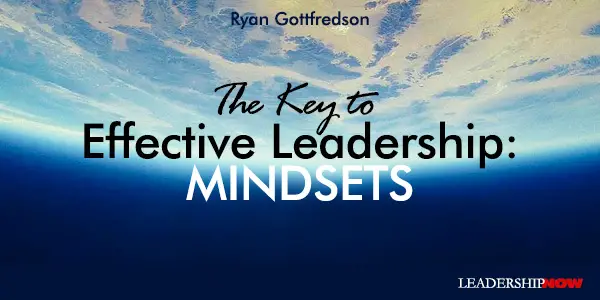
W To do so, consider four situations leaders can find themselves in:
Here is a table that shows two different leaders and how they each see and interpret these situations differently.
Who would you rather follow, Leader A or Leader B? Every group I speak to always says “Leader B.” But here is what is interesting, through a personal assessment I have done with over two thousand leaders and individuals, only 5% consistently operate like Leader B. What this hopefully demonstrates is that effective leadership is born not out of what leaders do or what behaviors they engage in, but first and foundationally in how they see and interpret the situations they find themselves in. So, what causes leaders to encounter the same situations, but interpret them so differently?
For example, consider a leader that has a subordinate that suggests that the leader could improve in some way. Depending upon the leader’s mindset, the leader could see that feedback as an indicator that the employee: (1) is questioning his/her leadership abilities and get defensive, or (2) cares about him/her and wants him/her to be as effective as possible. Thus, in this instance, the leader’s mindset drives how the leader thinks about the feedback, how likely the leader is going to learn from the feedback, and the manner in which the leader will behave in response to the feedback. Four Mindsets Necessary for Leadership Effectiveness If leaders’ mindsets are what drives their effectiveness, do you know what mindsets you need to develop to think, learn, and behave in the most effective way as a leader? Although mindsets are foundational to leaders’ effectiveness, most groups I speak to are unable to identify a specific mindset that is essential for leadership effectiveness. After learning about the power of mindsets and the foundational role they play in leadership effectiveness, I sought to identify the mindsets that drive effective leadership. As a leadership researcher, I scoured the academic literature, and I identified four sets of mindsets in largely four different areas of study (e.g., psychology, management, education, marketing) that have been studied for decades. While research associated with each set has repeatedly demonstrated that the mindsets influence individuals’ thinking, learning, and behavior, they have all be isolated from each other. Until now. I have pulled these different mindsets together into one framework to help leaders clearly identify the mindsets they need to develop to operate more effectively. Each set of mindsets represents a continuum from negative to positive as follows:  Every leader possesses a mindset that lies somewhere along each continuum, and the basic idea is that the more positive one’s mindset, the more effectively they are to think, learn, and behave in the situations that they encounter on a daily basis. Let me describe each set. Fixed/Growth
When leaders possess a fixed mindset, they seek to avoid failure, because, to them, failure means that they are a failure. Thus, those with a fixed mindset are primarily focused on looking good, and if something does not come easily or naturally to them, they have a tendency to give up. Leaders with a growth mindset, on the other hand, are primarily focused on learning and growing. They embrace challenges, see failure as an opportunity to learn and grow, and believe that success only comes through pushing through obstacles and difficulties. Closed/Open
Here is a great quote from Farnam Street: “Before you smugly slap an open-minded sticker on your forehead, consider this: closed-minded people would never consider that they could actually be closed-minded. In fact, their perceived open-mindedness is what’s so dangerous.” When leaders possess a closed mindset, they are primarily concerned about being seen as being right. As such, they seek to have their ideas supported, inclined to provide answers (as opposed to asking questions), avoid feedback and new perspectives, and see disagreement as a threat. All because they believe that what they know is best. When leaders possess an open mindset, they are primarily concerned about finding truth and thinking optimally. In order to do this, they ask questions, seek to understand, seek feedback and new perspectives, and see disagreement as an opportunity to learn. All because they believe that their perspective is limited and they can be wrong. Prevention/Promotion
Leaders with a prevention mindset are like a ship captain whose primary objective is to not sink. When this is the leaders’ objective, s/he focuses on ensuring no problems occur, limiting risk, and not “rocking the boat” (i.e., maintaining the status quo). Leaders with a promotion mindset are like a ship captain whose primary objective is to get to a specific destination. As such, the leader anticipates problems, sees risk as being necessary to reach the destination, and is willing to adjust operations to reach the destination. The difference between these two leaders is that those with a prevention mindset get blown about by the winds and the currents of the sea and end up in a destination not of their choosing, while those with a promotion mindset are willing to brave the winds and the currents of the sea to end up in a destination of their proactive design. Inward/Outward
When leaders have an inward mindset, they see themselves as being more important than others and are limited in their sensitivity to the feelings and emotions of those that they lead. And, when something goes wrong, they place the blame on others. When leaders have an outward mindset, they see others as being as important, if not more important, than themselves. And, when something goes wrong, they ask themselves: “Who am I being that their light is not shining.” Becoming a More Effective Leader Who would you rather follow, a leader whose mindsets are:
The effect of such leaders are just like they sound. Leaders with negative mindsets are constricting. Leaders with positive mindsets are expanding. What mindsets do you possess? Correspondingly, what type of leader are you because of your mindsets? Again, from my personal mindset assessment, I have found that only 5% of people consistently possess all four positive mindsets. If you are interested in learning how positive your mindsets are relative to thousands of others, I invite you to take my free personal mindset assessment. It will provide you with a personalized and comprehensive report to help you better understand each mindset set, what your mindsets are, and direction on how to improve your mindsets. In all: The key to being an effective leader is your mindsets.  
Posted by Michael McKinney at 12:19 PM
03.05.18

6 Steps to Building a Community
I Organizational health is facilitated by building community within your organization. It’s not easy, and it can’t be forced. Community is a long-term solution to engagement, commitment, and talent retention. In The Power of Community, Howard Partridge has broken down the process of building a community within your organization into three keys with six action steps. Support The first key to building community in your business is supporting your team members. “Many employees feel no one care about them. What if you started helping your team members reach their goals in life? This is a major key to the whole idea of community. In order to get support, we have to give support.” So this is where you begin: 1. Value True Community
2. Pursue Champion Connection
Encouragement
3. Inspire Emotional Trust
4. Practice Gift Exchange
Accountability The final key to building community in your business is accountability—the ability to accept responsibility for one’s own actions. “Accountability is key to becoming the person you were created to be. That’s because it is only by being accountable that you can discover and develop your gifts and help others discover and develop theirs.” This means that you first “have to take responsibility for your own actions, be respectful to your team members, be open to them, and allow yourself to be vulnerable. You also have to be willing to admit when you’re wrong, confess that you don’t have all the answers, and ask your team for feedback on how you’re doing as a leader.” Build accountability by: 5. Invite Openhearted Encounters
6. Build Growth PODS
You can begin the process by creating your first POD. A free POD template for each of the chapters of this book are available to download at HowardPartridge.com/PODS Go build your community. 
Posted by Michael McKinney at 07:45 AM
06.20.17

Humility is the New Smart: Are You Ready?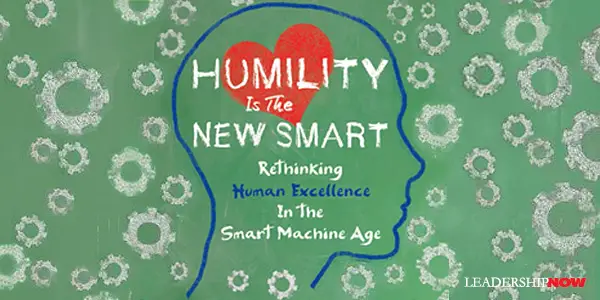
S Are you ready? The Smart Machine Age (SMA) will revolutionize how most of us live and work. In Humility is the New Smart, the authors state that “smart technologies will become ubiquitous, invading and changing many aspects of our professional and personal lives and in many ways challenging our fundamental beliefs about success, opportunity, and the American Dream.” This means that the “number and types of available jobs and required skills will turn our lives and our children’s lives upside down.” New skills will be needed. Uniquely human skills. Those skills, while uniquely human, are not what we are typically trained to do and require a deal of messy personal development. We will need to become better thinkers, listeners, relators, and collaborators while working to overcome our culture of obsessive individualism in order to thrive in the SMA. Humility is the mindset that will make all of this possible. Most of today’s adults have had no formal training in how to think, how to listen, how to learn and experiment through inquiry, how to emotionally engage, how to manage emotions, how to collaborate, or how to embrace mistakes as learning opportunities. In short, say the authors, we need to acquire and continually develop four fundamental NewSmart behaviors: Quieting Ego Quieting Ego has always been the challenge for us humans. As they observe, “Even if we don’t consider ourselves part of the ‘big me’ cultural phenomenon, for many of us to feel good about ourselves we have to constantly be ‘right,’ self-enhance, self-promote, and conceal our weaknesses, all of which drive ego defensiveness and failure intolerance that impedes higher-level thinking and relating.” This tendency negatively affects our behavior, thinking, and ability to relate to and engage with others. Managing Self—Thinking and Emotions We need to get above ourselves to see ourselves impartially. We all struggle “to self-regulate our basic humanity—our biases, fears, insecurities, and natural fight-flee-or-freeze response to stress and anxiety.” We need to be willing to treat all of our “beliefs (not values) as hypotheses subject to stress tests and modification by better data.” Negative emotions cause narrow-mindedness. Positive emotions, on the other hand, have been scientifically linked to “broader attention, open-mindedness, deeper focus, and more flexible thinking, all of which underlie creativity and innovative thinking.” Reflective Listening Because we are limited by our own thinking, we need to listen to others to “open our minds and, push past our biases and mental models, and mitigate self-absorption in order to collaborate and build better relationships.” The problem is “we’re just too wired to confirm what we already believe, and we feel too comfortable having a cohesive simple story of how our world works.” Listening to others helps to quiet our ego. Otherness To create these new behaviors and mindsets, it should become obvious that we need to enlist the help of others. “We can’t think, innovate, or relate at our best alone.” As Barbara Fredrickson observed, “nobody reaches his or her full potential in isolation.” Jane Dutton out it this way: “It seems to be another fact that no man can come to know himself except as the outcome of disclosing himself to another.” The NewSmart Organization Optimal human performance in the SMA will require an emphasis on the emotional aspects of critical thinking, creativity, innovation and engaging with others. “The work environment must be designed to reduce fears, insecurities, and other negative emotions.” To do this it means “providing people a feeling of being respected, held in positive regard, and listened to. It means creating opportunities for people to connect and build trust. “It means allocating time and designing work environments that bring people together to relate about nonwork matters.” Finally, it means getting to know employees and helping them to get the “right training or opportunities to develop and provide feedback.” The NewSmart organization needs to be a safe place to learn. “Feeling safe means that you feel that your boss your employer, and your colleagues will do you no harm as you try to learn.” 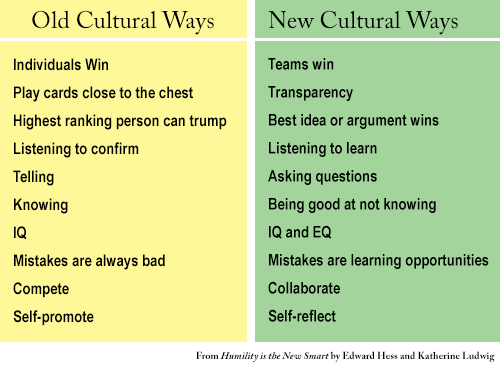 
Posted by Michael McKinney at 05:28 PM
06.09.17

9 Things Positive Leaders Do
J Positive leadership is grounded in reality. We must confront the negativity we come across, but we shouldn’t dwell on it. We deal with it and move on. It is because we will have to overcome negativity, adversity, and problems that we should be positive. “Positive leadership is not about fake positivity. It is the real stuff that makes great leaders great.” Positive leaders focus on solutions. Gordon cites psychologist Barbara Fredrickson’s research that finds that “people who experience more positive emotions than negative ones are more likely to see the bigger picture, build relationships, and thrive in their work and career, whereas people who experience mostly negative emotions are more likely to have a narrower perspective and tend to focus more on problems.” Positivity doesn’t guarantee you will succeed, but it makes it much more likely. A positive mindset reveals possibilities and gives you the courage to take the actions required to move past negative situations. Gordon explains nine things positive leaders do. Nine actions that will enhance your leadership capabilities and positively impact all of your relationship—your family, your friends and your team. 1. Positive Leaders Drive Positive Cultures Culture is everything. A positive leader lives the culture because it is an extension of who they are. “They understand that every day there are forces seeking to sabotage their culture and success, and so they work relentlessly to keep it strong.” “When you create a culture worth fighting for and invest in your people to the degree that they want to fight for your culture and for each other, your organization will have grit and strength to overcome the challenges you face and become an unstoppable and positive force.” 2. Positive Leaders Create and Share a Positive Vision Former President and Chief Executive Officer of the Ford Motor Company Alan Mulally, said, “Positive leadership—conveying the idea that there is always a way forward—is so important because that is what you are here for—to figure out how to move the organization forward.” Positive leaders see and create a brighter and better future. They see “what’s possible and then take the next steps to rally and unite people to create it. Every invention, project, creation, and transformation starts with an idea, an imagination, and a vision of what’s possible.” A positive leader needs a telescope and a microscope. The telescope helps to keep your eyes on the big picture. The microscope helps the leader to focus in on what needs to be accomplished in the short term to realize the vision in the telescope. “If you only have a telescope, then you’ll be thinking about your vision all the time and dreaming about the future but not taking the necessary steps to realize it. If you only have a microscope, then you’ll be working hard every day but set-backs and challenges will likely frustrate and discourage you because you’ll lose sight of the big picture.” 3. Positive Leaders Lead with Optimism, Positivity, and Belief “Ultimately, being a positive leader is all about leading with faith in a world filled with cynicism, negativity, and fear.” We all face this battle between faith and fear. A leader’s job is to fill your people with faith. How we respond to our world depends on the stories we tell ourselves. When you face adversity you can tell a positive story and then work to create a positive outcome. It’s always your state of mind and your thinking that produces how you feel and respond. When you see that the world has no power over you, you will lead more powerfully in the world.” 4. Positive Leaders Confront, Transform, and Remove Negativity “Positive leadership is not just about feeding the positive, but also about weeding out the negative.” You must address negativity. Develop a culture where negativity is not acceptable. People will either change or leave. A positive leader is more positive than the negativity they face. Every negative situation is an opportunity the strengthen your positivity. Don’t allow complaining unless one or two possible solutions are brought forward also. “Complaining causes you and your team to focus on everything but being your best.” 5. Positive Leaders Create United and Connected Teams “Positive leaders unite instead of divide. They are able to create unity, which is the difference between a great team and an average team.” It starts at the top. “As a positive leader, you must be a unifier and connector who fosters relationships between others.” “You can be the smartest person in the room but if you fail to connect with others you will fail as a leader.” Also, “You may not have the most talented people on your team, but if you are a connected team, you will outperform many talented teams who lack a close bond.” 6. Positive Leaders Build Great Relationships and Teams People first follow who you are. “Leadership begins with love.” Love your people. Build relationships first. Too many leaders share rules before they have first built a relationship. I’ve had many leaders tell me,” writes Gordon, “that when they focus less on rules and invest more in their relationships they experience a dramatic increase in performance, morale, and engagement.” Positive leaders are also positive communicators. They smile. They spread positive gossip. They listen and welcome ideas. They rely on positive non-verbal communication. They encourage. 7. Positive Leaders Pursue Excellence Not satisfied with the status quo, positive leaders pursue excellence. “How can I get better to make the world better?” Positive leaders are humble and never stop learning. Pablo Casals, one of the greatest cellists of all time, was asked why he continued to practice the cello at the age of 95. He said, “Because I think I’m making progress.” Positive leaders ask daily: “What do I need to know that I don’t know?” and “What do I need to unlearn to learn?” 8. Positive Leaders Lead with Purpose Purpose fuels positivity. “Hard work doesn’t make us tired. A lack of purpose is what makes us tired. We don’t get burned out because of what we do. We get burned out because we forget why we do it.” Have purpose-driven goals. “The truth is that numbers and goals don’t drive people. People with a purpose drive the numbers and achieve goals.” 9. Positive Leaders Have Grit “When we look at successful companies and organizations, we see their current success and prominence but what we don’t see is the leadership and grit that powered them through all the failure and moments of doubt, heartache, fear, and pain.” Positive leaders embrace failure and trust the process. “Leadership is knowing the critics will criticize you while still saying what needs to be said and doing what needs to be done.” Positive leadership is a choice. Through great stories, Gordon encourages you to make a positive difference as a leader. 

Posted by Michael McKinney at 08:58 AM
04.05.17

Radical Candor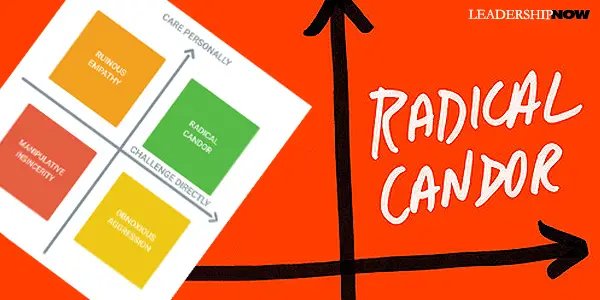
R The very heart of being a good boss is a good relationship, writes Kim Scott in Radical Candor. We need Radically Candid relationships with those we work with and because this is often scary and can be emotionally taxing, we resort to be ruinously empathetic or obnoxiously aggressive or manipulatively insincere. Of course, establishing trust with each person that reports to you is fundamental to radical candor. Radical Candor happens when you put Care Personally and Challenge Directly together. Care Personally refers to the fact that to have a good relationship “you have to your whole self and care about each of the people who work for you as a human being. Challenge Directly “involves telling people when their work isn’t good enough—and when it is. Challenging people might seem the opposite of Care Personally, but “challenging people is often the best way to show them that you care when you’re the boss.” Scott explains that she chose the word Radical “because so many of us are conditioned to avoid saying what we really think. This is partially adaptive social behavior; it helps us avoid conflict or embarrassment. But in a boss, that kind of avoidance is disastrous. She chose Candor because it is “necessary to communicate clearly enough so that there’s no room for interpretation, but also humbly.” Caring Personally is about acknowledging that we are all people with lives and aspirations that extend beyond those related to our shared work. It’s about finding time for real conversations; about getting to know each other at a human level; about learning what’s important to people; about sharing with one another what makes us want to get out of bed in the morning and go to work—and what has the opposite effect. Radical candor is not an invitation to be a jerk, or to nitpick, or to simply schmooze. (“A good rule of thumb for any relationship is to leave three unimportant things unsaid each day.”) What you say gets “measured at the listener’s ear, not at the speaker’s mouth.” Everything must be delivered in good faith. 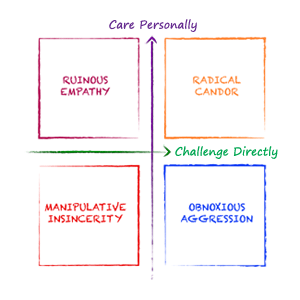 Scott has created a framework to help you be more conscious of the kind of guidance you are getting, giving, and encouraging. There are two dimensions to good guidance: Care Personally and Challenge Directly. It is a way to gauge praise and criticism. Scott has created a framework to help you be more conscious of the kind of guidance you are getting, giving, and encouraging. There are two dimensions to good guidance: Care Personally and Challenge Directly. It is a way to gauge praise and criticism.
When you criticize someone without taking the time to show care, your guidance feels like Obnoxious Aggression. It’s what happens when you challenge but don’t care. It’s praise that doesn’t feel sincere or criticism that isn’t delivered kindly. “When bosses belittle employees, embarrass them publically, or freeze them out, their behavior falls into this quadrant.” And keep this in mind: “Almost nothing will erode trust more quickly than using one’s insights into what makes another person tick to hurt them.” Manipulative Insincerity is what happens when you neither care nor challenge. It’s an attempt to push the other person’s emotional buttons in return for some personal gain. It’s praise that is non-specific and insincere or criticism that is neither clear nor kind. Ruinous Empathy is what happens when you care but don’t challenge. “When bosses are too invested in everyone getting along, they also fail to encourage the people on their team to criticize one another for fear of sowing discord. They create the kind of work environment where ‘being nice’ is prioritized at the expense of critiquing, and therefore, improving actual performance.” It is praise that isn’t specific enough to help the person understand what was good or criticism that is sugarcoated and unclear. You may think Radical Candor would never work on your organization’s or team’s culture. And it probably won’t unless you first invest in the people you work with and show them that you care personally. But here’s the big hurdle: Start by explaining the idea and then asking people to be Radically Candid with you. Why you first? First, it’s the best way to show that you are aware that you are often wrong and that you want to hear about it when you are; you want to be challenged. Second, you’ll learn a lot—few people scrutinize you as closely as do those who report to you. Third, the more firsthand experience you have with how it feels to receive criticism, the better idea you’ll have of how your own guidance lands for others. Fourth, asking for criticism is a great way to build trust and strengthen your relationships. (Important: “If a person is bold enough to criticize you, do not critique their criticism.”) Scott carefully details ways to create a climate in which Radically Candid relationships can flourish. She provides many (most first-hand) examples of what worked and what didn’t work. From her experiences at Apple and Google, she observed that “a boss’s ability to achieve results had a lot more to do with listening and seeking to understand than it did with telling people what to do; more to do with debating than directing; more to do with pushing people to decide than with being the decider; more to do with persuading than with giving orders; more to do with learning than with knowing.” And there’s an app: Candor Coach. This app will show you how quick, frequent, face-to-face conversations can help you build a culture of Radical Candor. It will start by teaching you to ask for and give feedback. It will help you track the conversations you’re having with each person on your team so that you can see where you need to improve.   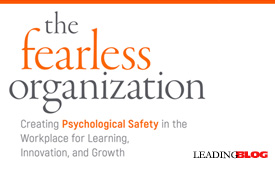
Posted by Michael McKinney at 09:32 PM
10.10.16

Todd Durkin on Leadership & People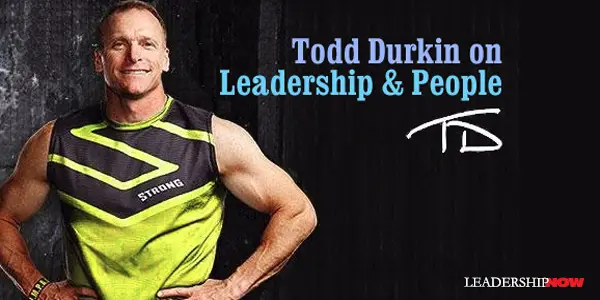
TODD DURKIN is one of America's top fitness trainers helping people move beyond their perceived limits from the inside out. The principles he uses in his approach to his work are something all leaders can consider and apply. Durkin brings servant leadership to all that he does. He has been motivating others with his Word of the Week (WOW) since 2011 and has now compiled them in a single book, The WOW Book. His WOW chapter titled Leadership and People is on–target. He writes: I love studying great coaches. In any sport. And on all levels. One of those coaches is Dick Vermeil. Coach Vermeil coached three different NFL teams. The Philadelphia Eagles. The St. Louis Rams. And the Kansas City Chiefs. In 1999, he led the Rams to a Super Bowl championship. He amassed 126 wins in his 29-year NFL head-coaching career. And he was a three-time NFL Coach of the Year. He has positively impacted thousands of men in his coaching tenure. On this one particular evening in 2013, I had the opportunity to hear him speak to a few hundred fitness trainers/pros at a Perform Better conference in Providence, Rhode Island. And he was awesome! Coach Vermeil revealed his “Seven Common Sense Coaching Points” that make the foundation for any team, business, company, or family. In all seven points, there was ONE commonality: PEOPLE. Without great PEOPLE, there are no great businesses, no great TEAMS, no great organizations, no great families, no great companies, and no great brands. Coach Vermeil talked about how the most important resource of any company is its PEOPLE: their personal dignity, pride in what they do, and the trust that they have in management. At the end of every business/calendar year an important and first question a LEADER should ask is: Do we have better people in our company? Do we have better people on December 31st (the year’s end), than we did on January first (the year’s beginning)? Are we better TODAY than we were at the start of the year? Think about what Ford says in its MISSION statement: “Our PEOPLE are the source of our strength.” Think about what Hilton Hotels says in its VALUES statement: “PEOPLE are our most important asset.” YOU are a LEADER of your business, your TEAM, your family, your organization . . . regardless of your title! Your PEOPLE need to know what to expect.

Posted by Michael McKinney at 08:26 PM
11.11.15

A Framework of Organizational Tensions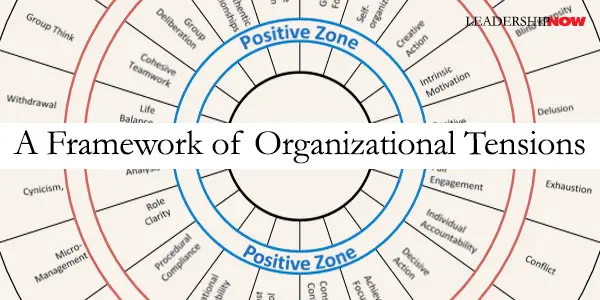
TENSIONS are objectives that seem to be in conflict. They are values that seem to be in opposition. We often treat them as either/or choices when they should be treated as both/and dynamics. Each value or characteristic supports and even makes possible the competing value. Robert Quinn has produced a valuable tool for understanding this concept in his book The Positive Organization. What makes it especially valuable is that it illustrates the options we have to the single values we hold so dear—there are possibilities and equally effective “right” solutions we can use to move us forward. We tend to focus on the value that resonates most with us or the ones we are most familiar with. This often causes us to get stuck or to jump from one ditch to the other never realizing the true potential of our organization. (This dynamic plays out in our personal lives as well.) 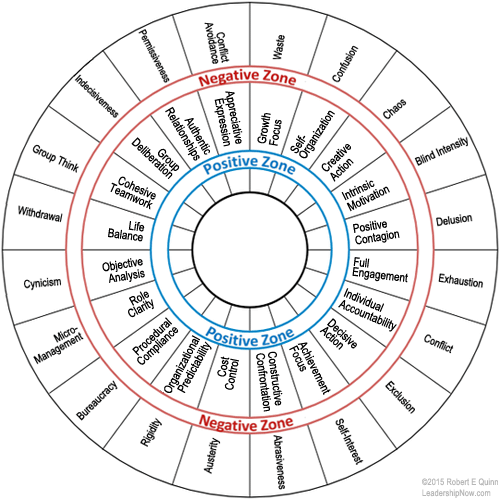 You will notice that each of the positive values in the inner circle is associated with a negative value on the outer circle. If we champion one value over another we put our organizations at risk for the negative outcomes associated with each of the 20 values on the diagram. Every positive value without its contrasting value can become a negative in much the same way the overuse of a strength becomes a weakness. For example, we need some predictability and control in any organization, but too much leads to rigidity. We also need some spontaneity and self-organization for people to flourish, but again too much can lead to organizational and personal chaos. We also miss the larger picture and usually misinterpret issues.  A person who seeks a predictable, smooth running organization often focuses on disruptions and disruptive influences; the natural inclination is to fix those disruptive problems. When we focus on a problem, we are not seeing the whole system. We are paying attention to something within the system. Likewise, when we focus on a single person, we are not focusing on the culture of which that person is a part.When we have an agenda we tend not to see the whole picture. As leaders we need to see the broader context of every situation. It’s not about finding balance. It’s about emphasis—where to place the emphasis and when. Of Related Interest: 
Posted by Michael McKinney at 04:45 PM
06.20.14

How to Lead from PossibilitiesProblems are always with us, but we don’t want to lead from problems. Lead from possibilities. Lead from the why. Lead with courage.Kathryn Cramer calls this Lead Positive. “When you think, speak, and act out of the positive side of the ledger, others feel more hopeful and confident about the future.” Cramer has created a 3-step process for reframing what we see, say and do so that we operate more from a positive outlook than a negative one. What they SEE – how to see more of the possibilities than the problems of any given situation What they SAY – how to connect the positive things you see to what you say to others What they DO – how to use the positive trajectory of what you see and say to act intentionally Cramer is the co-author with Hank Wasiack of the very good, Change the Way You See Everything Through Asset-based Thinking. She has taken those principles and applied them specifically to leaders and leadership. She writes: Asset-based thinking (ABT) means to look at yourself and the world through the eyes of what is working, what strengths are present, and what the potentials are. [Reminds me a bit of the ideas found in Moneyball.] Conversely, deficit-based thinking means to look at yourself and the world in terms of what is not working, what is lacking, and the gaps between where you are and where you want to be.Deficit-based thinking tends to be our default and is very draining on both ourselves and those around you. So ABT has to be a deliberate choice. ABT builds on what is working with people and in situations. Our most difficult situations – the negative ones – are the ones that will benefit most from positive or asset-based thinking. For example, when people disagree with us it can quickly turn to anger. Cramer suggests that the best ABT strategy in response to conflicting points of view is to “be curious enough to find out why people oppose you.” It’s not about finding common ground – areas of agreement – but finding commonality – getting to a place where opposing parties understand where each other is coming from. “Curiosity sows the seeds of trust and creates opportunities to see value in somebody else’s points. When conflicting parties trust and can see the value in each other’s positions.” Leading positive begins with you. It begins first with knowing your own assets – “to know beyond a shadow of a doubt who you are and what you are capable of.” We operate out of a perceptual set that biases our attention and what we see in any given situation. And that affects how we engage with those we lead. Once you see yourself from a positive perspective you leverage the positive assets in the people around you. Of Related Interest: 
Posted by Michael McKinney at 04:29 PM
04.15.13

Nice Companies Finish First
WHEN you have the power usually associated with leadership, it's easy to begin thinking that you can do anything you want. You can treat people any way you want. Sometimes it works in the short term, but it never works in the long term. It's self-centered, and it eventually kills your influence. It's the core message of Nice Companies Finish First by Peter Shankman: "Being a selfish bastard who doesn't believe the rules apply to you simply won't get you very far." Shankman cites a study where 700 people from a variety of industries reported on the treatment they received from their managers: 31% reported that their supervisor gave them the "silent treatment" during the year.
And it goes on. Not surprisingly, this kind of abusive behavior results in a workforce that "experienced more exhaustion, job tension, nervousness, depressed mood, and mistrust." Shankman says your manager might be a jerk if they: are a know-it-all dictator, are uninterested in feedback, take sides unfairly and openly, are wasteful of resources, are a Desert Island boss (non-existent), a builder of empires, are a talker and not a doer, think adversaries work better than teams or are in a constant cycle of crisis. The Nine "Nice" Characteristics Shankman then identifies nine "nice" characteristics that will eradicate "jerk" behavior beginning with "enlightened self-interest" since it underpins all of the others. A leader with enlightened self-interest will think in terms of the transactional benefits of everything they do. To be sure, there are times when a leader must make unpopular decisions, but, says Shankman, "you can make beneficial decisions and lead your company to greatness without resorting to third-grade schoolyard tactics." An enlightened leader is accountable, invests in others, consults with those affected by decisions, seeks counsel, expects the truth, and reacts mindfully and positively to any situation. The other traits he describes are: Accessibility (Inaccessible, aloof CEOs can run successful businesses for a while, but in the long run, they make bad leaders.), Strategic Listening (leadership is "a lot less about convincing people and more about benefiting from complex information and getting the best out of the people you work with. Listening for comprehension helps get you that information, of course, but it's more than that; it's also the greatest sign of respect you can give someone."), Good Stewardship (Good stewardship is about responsible management and ethical standards that are in sync with the concerns of all of the constituents who are important to your business, including shareholders, stakeholders, investors, neighbors, and communities.), Loyalty (360 Loyalty–loyal to what works for the whole company and for all good employees.), Glass-Half Full POV (Seeing the difference between "Everything's OK!" and "Everything will be OK if we do the following things."), Customer Service-Centric ("Makes it easy for people to become and stay customers in every way possible." Serving first selling second.), Merit-Based Competitor (Compete by differentiation. It's OK to be nice to your competition. Kill them with kindness.), and Gives a Damn ("Turning down the easy buck to instead do the right thing is one of the hardest choices we have to make."). You can't fake being nice. "As communication becomes more fluid, leaders will be more exposed. We won't be able to hide anything anymore."

Posted by Michael McKinney at 12:14 AM
12.09.11

3 Ways to Be a Positive Leader
IN A WORLDIn a world filled with busyness and stress, I find that too often leaders can act like hard-charging, fast-driving bus drivers that have a vision and goal within their sights and they’ll run over anyone – even their own employees – to reach their destination. I know this well because early in my business career I was that kind of leader and I have had to work hard to change my approach. I realized that any hard-charging leader can create success in the short term, but it would take a positive leader with a people and process-driven approach to build a successful organization for the long term. As John Maxwell said, “If you are all alone at the top, you are not a leader. You are a hiker.” No one creates success alone. To win in business, you must win with people. Running over people will only get you so far. To create true and lasting success you must nurture and invest in your people. Here are 3 essential ways to do this Care about them – The main question every employee in every organization is asking is, “Do you care about me; can I trust you?” Employees want to know if you care about them. If you do, they will be more likely to stay on the bus and work with you. Employees are more engaged at work and will work at their highest potential when their manager cares about them. Develop a relationship with them – Author Andy Stanley once said, “Rules without relationship lead to rebellion.” Far too many managers and leaders share rules with their people, but they don’t have a relationship with them. So what happens? The people rebel, and they disengage from their jobs and the mission of the team. I’ve had many managers approach me and tell me that my books helped them realize they needed to focus less on rules and invest more in their work relationships. The result was a dramatic increase in team performance and productivity. To develop a relationship with your employees, you need to build trust, listen to them, make time for them, recognize them and mentor them. Appreciate them – The main reason why people leave their jobs is because they don’t feel appreciated. For example, Doug Conant, the CEO of Campbell Soup, has written more than 16,000 thank-you notes to employees in the past seven years and created a very positive business in the process. It’s as easy as saying (or writing) “Thank you.” It’s a simple truth: When you care about your employees and the people you work with, they are more likely to stay on the bus and work harder, with more loyalty and greater positive energy. In turn, they are more likely to share their positive energy with your customers, thus enhancing service and the bottom line. The greatest customer-service strategy has nothing to do with customer service, but it has everything to do with how you treat your employees. If you model great service, they will provide great service. Remember, leadership is not just about what you do, but what you can inspire, encourage and empower others to do. Instead of running over the people in your team/organization, invite them on the bus with you and engage them to help you create an amazing and successful ride.  
Posted by Michael McKinney at 02:06 PM
04.12.11

From Values to Action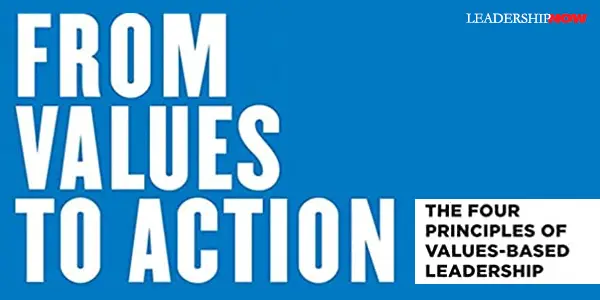
FORMER chairman and chief executive officer of Baxter International, Harry Kraemer, has written a genuine, back-to-basics book on value-based leadership: From Values to Action. He presents four interconnected principles that build on and contribute to each other: Self-Reflection is the most important and is central to your leadership. “If you are not self-reflective, how can you truly know yourself?” writes Kraemer. “If you do not know yourself, how can you lead yourself? If you cannot lead yourself, how can you possibly lead others?” Self-reflection allows you to transform activity into productivity for all the right reasons. It means “you are surprised less frequently.” It is essential in setting priorities. You can’t do everything. So reflection makes it possible to answer key questions like What is most important? and What should we be doing? in a way that is in line with your strengths and values and organizational goals. Engaging in self-reflection on a regular, ongoing basis (preferably daily) keeps you from becoming so caught up in the momentum of the situation that you get carried away and consider actions and decisions that are not aligned with who you are and what you want to do with your life. Balance and Perspective is the ability to understand all sides of an issue. Pursuing balance means you will have to grasp the fact that leaders don’t have all the answers. Kraemer says, “My task was to recognize when a particular perspective offered by one of my team members was the best answer….Leadership is not a democracy. My job as the leader is to seek input, not consensus.” Because he believes we are more effective if we balance all areas of our life, he prefers the term “life balance” over “work-life balance.” It’s not an either-or proposition. “When you identify too closely with your work, you can easily lose perspective and become unable to look at all angles in a situation.” He recommends implementing a “life-grid” to keep track of where you are spending your time and to hold yourself accountable. True Self-Confidence is know what you know and you don’t know; to be comfortable with who you are while acknowledging that you still need to develop in certain areas. (Comfortable not complacent.) Why TRUE self-confidence? There are people who adopt a persona that might make others think that they have self-confidence, but they are not the real deal. Instead, they possess false self-confidence, which is really just an act without any substance. These individuals are full of bravado and are dominating. They believe they have all the answers and are quick to cut off any discussion that veers in a direction that runs contrary to their opinions. They dismiss debate as being a complete waste of time. They always need to be right—which means proving everyone else wrong. Genuine Humility is born of self-knowledge. Never forget where you started. “Genuine humility helps you recognize that you are neither better nor worse than anyone else, that you ought to respect everyone equally and not treat anyone differently just because of a job title.”
Kraemer describes a values-based leader well: “Self-reflection increases his self-awareness. Balance encourages him to seek out different perspectives from all team members and to change his mind when appropriate in order to make the best possible decisions. With true self-confidence, he does not have to be right, and he easily shares credit with his team. Genuine humility allows him to connect with everyone because no one is more important than anyone else.” From Values to Action is an outstanding book and filled with important concepts that any would-be leader would benefit from. 
Posted by Michael McKinney at 04:13 PM
01.28.11

10 Ways to Make Others Shine Earl Miller, a neuroscientist at MIT says, “Success has a much greater influence on the brain than failure.” Ned Hallowell comments in Shine: While of course mistakes need to be acknowledged and, one hopes, learned from, it may be more likely, from a purely neurological point of view, that a person will learn more from a success than a failure.” Earl Miller, a neuroscientist at MIT says, “Success has a much greater influence on the brain than failure.” Ned Hallowell comments in Shine: While of course mistakes need to be acknowledged and, one hopes, learned from, it may be more likely, from a purely neurological point of view, that a person will learn more from a success than a failure.”
Hallowell points out that acknowledgment or recognition serves two important functions. Of course there is the familiar purpose of giving the recipient encouragement, motivation and greater confidence, but recognition also promotes moral behavior through connection. Hallowell explains: “When a person feels recognized and connected to the larger group, she knows viscerally, not just intellectually, that she has made a contribution others value. Not only does this motivate her to do more and try harder, but it instills a desire to look out for the larger group…. It leads a person to do the right thing even when no one is looking.” Showing appreciation and giving recognition is part of the Cycle of Excellence process he calls shine. In our busy culture it is easy to overlook opportunities to acknowledge others. Noticing the positive is a daily challenge. In Shine, Hallowell offers these ten tips for promoting shine with the people you influence:
How do you make others feel valued? Related Interest:
Posted by Michael McKinney at 12:06 PM
01.27.11

The Cycle of Excellence: 5 Steps to Peak PerformancePsychiatrist Edward Hallowell says that to bring out the best in people you have to focus on the interaction between what is within a person and what lies outside. Properly aligned, you can achieve peak performance. By peak performance he means “consistent excellence with improvement over time at a specific task or set of tasks.” “While no one has ever achieved the goal of ‘being all they can be,’” he says “everyone has it in them to deliver peak performance defined in that way.”In Shine: Using Brain Science to Get the Best from Your People, Hallowell, combines brain science and performance research to help you get the most out of people’s brains (including your own). To ignite peak performance, he has created a process called the Cycle of Excellence. It is a five step process, that when followed completely, leads to excellence. The steps are:
Unfortunately the modern world works against us. Hallowell has identified two paradoxes of modern life. First, “While we have grown electronically superconnected, we have simultaneously grown emotionally disconnected from each other.” Disconnection short-circuits the Cycle of Excellence more quickly than anything else. “Disconnection is one of the chief causes of substandard work in the modern workplace. But it is one of the most easily corrected.” The second paradox is that “people’s best efforts often fail not because they aren’t working hard enough, but because they are working too hard.” Overwhelmed with data, we try to compensate by working harder trying to process more data. What we should be doing is erecting boundaries to regulate what we allow in. Leaders need to be helping people to regulate their lives and manage technology rather than pushing them to do more. Greater connection and engagement will result. 
Posted by Michael McKinney at 11:50 PM
08.25.10

Dispute Catastrophic Thoughts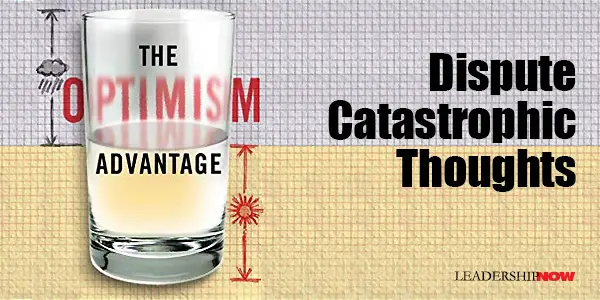
WARREN BENNIS wrote in Leader to Leader that “every exemplary leader that I have met has what seems to be an unwarranted degree of optimism—and that helps generate the energy and commitment necessary to achieve results.” Optimism says Bennis, “the sense that things generally work out well, creates tremendous confidence in oneself and in those around one.” Optimism helps leaders to be more resilient as they tend to believe in their capacity for self-control and the ability to overcome obstacles that come their way. In short, I would say, optimism is finding perspective. In The Optimism Advantage, Terry Paulson offers fifty truths for cultivating optimism beginning with “Life is Difficult.” (Perhaps not what you would expect from a book on optimism.) He writes, “If you want to be a true optimist, start by being a realist. Accept that life is difficult, and then get busy learning as much as you can about the challenges you face. Why? Because you’ve overcome problems in the past, you have every reason to believe that you’ve got what it takes to overcome whatever problems life deals you.”One important place to begin is with our negative thoughts and feelings. Optimists dispute catastrophic thoughts, those “feelings that everything is wrong and that nothing is going to change.” Paulson says that “means you have to be ready to argue with some of your negative beliefs.” Optimism is “about facing and taking advantage of reality—even unsettling reality. Expecting unrealistic results may actually increase your dissatisfaction….To an optimist, it’s all about resilience and maximizing your results.” Start with understanding what it is you’re saying to yourself that is causing a bigger problem in your thinking. Clarify it and then take a critical look at your beliefs and dispute them. Are they valid? Is there another way to look at this? Seek alternate explanations. Optimists ask, “Is there any less destructive way to look at this or explain what happened?” Look for causes that you can overcome and focus on what can be changed and then take action. 
Posted by Michael McKinney at 12:36 AM
12.14.09

Lift: How to Be a Positive Force in Any Situation
TO OVERCOME the force of gravity—that which pulls us down—we have to generate an opposing force greater than gravity. That force is lift. Any opposition to lift is called drag. In the same way that we use the laws of physical science to lift a plane off the ground, we can use social science to lift “ourselves and others up to greater heights of achievement, integrity, learning, and love,” thereby becoming a positive force in any situation. It’s the pressures of daily living that drag us down. Instead of experiencing lift we fall back into our comfort zones, become reactive, self-centered and fatalistic. To intentionally experience lift and to be a positive influence for others, we have to make a conscious choice. In Lift: Becoming a Positive Force in Any Situation, authors Ryan and Robert Quinn present this fitting metaphor, to explain how we can intentionally experience lift, to rise above the constraints of everyday life and lift the people around us. “All of us have a choice: we can choose to be the kind of people who drag others down or to be the kind of people who lift…. We are relational beings. Who we are at any time depends on who the people around us are, and who they are depends on who we are.” That last sentence can’t be overemphasized. It carries with it a great deal of responsibility, especially for us as leaders. The authors describe lift as “a psychological state in which a person is purpose-centered, internally directed, other-focused, and externally open.” What exactly are these four characteristics of lift? In a very relatable and revealing example—the parenting of a young son, Mason—the authors show how this plays out in real life. I can’t reproduce the example here, but I think from the inferences you will get the idea the authors are trying to convey. The following is paraphrased from their work: Purpose-centered is the opposite of being comfort-centered. The desire to stay comfortable is a characteristic of a normal psychological state. My son Mason’s behaviors were comfortable for me. In my desire for comfort, what had not occurred to me was the possibility that perhaps Mason was behaving differently because of the changes that had happened recently in his life. We need to ask, “Are the results I am trying to create about me and what I am comfortable with or are they about what is best for the other person?” Internally directed is when people experience the dignity and integrity that comes with exercising the self-control necessary to live up to the values that they expect of others. External direction, on the other hand, is a characteristic of a normal psychological state. If Mason was building with his Legos or playing a game when I asked him to do something, I expected him to put those things aside and do it. Yet, if I was involved in an activity and Mason interrupted me, I would expect him to wait until I was done with my activity before I did what he asked. I expected him to show respect to me, but I was not doing the same for him...When people are externally directed, they let circumstances (such as the need to get Mason to clean up or go to bed) drive their behavior instead of their values (such as respect for others’ time and activities). Other-focused is to be open to other people’s feelings and needs. We then empathize with them and feel impulses to be compassionate. When we are self-focused, we are concerned only with our own needs, feelings, and wants. We see other people as objects that either helps us or impede us in our goals. In my case, Mason was an object that was preventing me from my goal of showing that I was a good father. Externally open is openness to external cues. When we are open we learn, grow and adapt ourselves to the situation unfolding before us. When we are internally closed, we ignore and deny feedback. We ignore or deny feedback out of fear that the feedback says something about our worth as human beings. So as a result, we tend to get angry. Again with Mason, I was not showing him the respect that I wanted him to show me. As I opened myself to the possibility that I might be wrong, I also opened myself up to what Mason was feeling, and to what his needs might be and became other-focused. Using scientific research to provide “insight into why lift is important, what the characteristics of lift are, and how our psychological states influence others,” they formulated four questions that capture the nuances required to intentionally move ourselves from a normal state into lift.
This post is getting long, but I would like to share several more thoughts for you to contemplate: When a new situation disrupts our previous expectations, though, it is more productive to change our expectations than to try to make the world conform to our old expectations. The book is full of great examples and scientific evidence to back their perspective. The scientific evidence is really just icing on the cake. The relational principles at work here are sound, but they require much thought and self-examination. This is a book that needs to be read and re-read. Inertia is our biggest enemy. Inertia will keep us from benefiting from this book and becoming a positive force; the kind of leaders that provide lift in our own lives and those we influence. 
Posted by Michael McKinney at 11:10 PM
07.27.09

5 Leadership Lessons: Getting Your Relationships Right Townsend wrote Leadership Beyond Reason to help you understand and utilize the soft skills – that which is beyond reason. He says “you ignore what is beyond reason at your own peril….Leading from your inner world ultimately produces better results in your leadership.” He divides our inner world into five areas: values, thoughts, emotions, relationships and transformation. As leadership is about connecting with those you lead and a primary focus of leadership, let’s pull five lessons from Townsend on relationships: Developing your relational abilities will help you read the landscape. Townsend adds, “The leader who misses relational aspects is surprised when people become distant, resentful, or just leave. The relational leader sees the signs coming a long way away and has time to do something about them.”
Posted by Michael McKinney at 09:51 AM
04.07.09

Are You a Perfectionist or an Optimalist?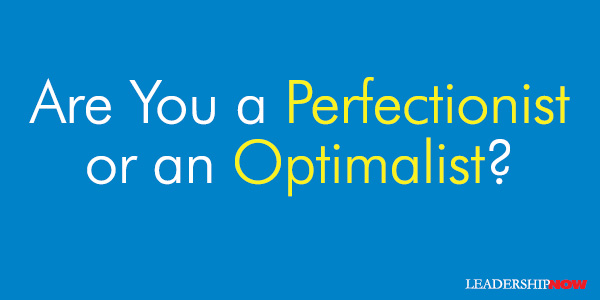
BEING happy or being perfect. You can have one, but you can’t have the other. The happy life is attainable, but the perfect life isn’t. In fact, trying to be perfect gets in the way of being happy (and productive). Imperfection is a by-product of being human. Perfectionism – the maladaptive and neurotic belief that you and/or your environment must be perfect and that work or output that is anything less than perfect is unacceptable – is not something that you are born with. It is developed. Contrary to the goal they seek, perfectionists are focused on failure. There’s a difference between setting high standards that spur us on and seeking perfection that demoralizes us. In The Pursuit of Perfect, author Tal Ben-Shahar refers to the two approaches as perfectionism and optimalism. Most of us are a little of both. “We may be Optimalists in some areas of our lives and Perfectionists in others. For example, we may be quite forgiving of mistakes we or others make on the job but be thrown into despair when our expectations are not fully met in our relationships.” Consider these statements:The key difference between the Perfectionist and the Optimalist is that the former essentially rejects reality while the latter accepts it.  Ben-Shahar discusses these ideas in detail and then shows how they apply to and play out in education, the workplace, and in relationships. He offers exercise and meditation to help you reorient your thinking and move from perfectionist thinking to optimalist thinking. It’s easy to see from his approach and the advice given in this book, why his Harvard course in “Positive Psychology,” is the most popular class in the university’s history. Read it. I’m certain you’ll benefit.

Posted by Michael McKinney at 09:33 AM
03.04.09

Take the Greater Than Yourself ChallengeYou’ve heard “invest yourself in others” and “pay it forward.” Steve Farber has his own unique twist on these ideas and he calls it Greater Than Yourself.The Greater Than Yourself (GTY) concept is based on the premise that great leaders become great because they cause others to be greater than they are. GTY is a one-on-one development process where you choose to help someone become more capable, competent, and accomplished than you are. It has three parts to it: Expand Yourself, Give Yourself and Replicate Yourself. The life-long process begins with you. “You have to expand yourself before you can help make others greater.” That means that you have to make sure that everything that is you is constantly expanding. No matter how much you think you know or are, “you can always learn more, you can always experience more, you can always connect more and love more.” The point of which is to give it all away. Giving it all away always brings out the cynics. But Farber deals with that too. Giving it all away seems to imply subtraction – like a zero-sum-game – to many people. But it’s not. Giving it all away really adds to who you are. Parents get it, but when we get outside that relationship, an improper self-interest kicks in and we miss the bigger picture. In this business fable set along the California coast, Faber skillfully explains the true nature of giving it all away to become a creator of masters. GTY has life-changing possibilities if you commit to it. Expanding yourself “is a practice that should become part of your life. Integrate it into your thought process and into the way you make decisions. Will X add to your inventory? Will it expand an item that is already there? If so, do it; if not, don’t.” When you think of giving of yourself, money may not be part of it. You have other resources like “your talent, your knowledge, your connections, your confidence, your trust” and last but not least, “your time.” In the end, you want to replicate yourself. That is, you want to make sure that the people you elevate are doing the same for others. In an organizational context, it might look like this: “Everyone on my team and in our company should become significantly greater as a result of working with one another.” But, “I’m not trying to hire people who are more talented than me, I’m trying to hire people with heart, desire, drive, and mad potential, and then encourage all of them to bring out the best in one another by giving fully to one another. See the difference?” Farber admits that this isn’t easy to do initially. In response, he challenges us to pick just one person to make a GTY project. “Raise that person; boost him or her above yourself. Start there and see what happens.” He has created a web site with examples and resources to get you going. In particular, there is a four minute video of a GTY project conducted by the Up With People organization, that is a good overview of what this is all about and the impact it can have. The participants in this GTY project don’t rule out that great things can come in small packages. The tendency is to pick someone who is already doing well and then working to make them greater; jump on their bandwagon so to speak. There’s certainly nothing wrong in that, but perhaps the most impact can come from taking someone who really needs a leg up and connecting them to what they need. Take the Greater Than Yourself Challenge. Pick one person and give of yourself to make their life better—than yours!

Posted by Michael McKinney at 04:23 PM
10.17.08

Positive Relationships: It's About Them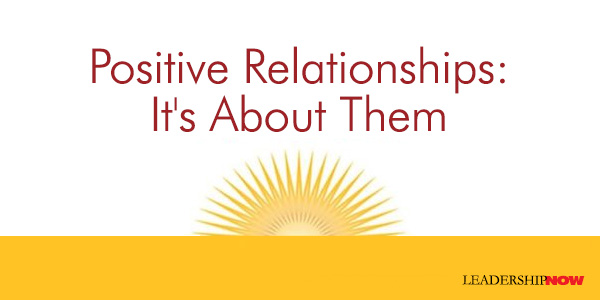
it is what people give to a relationship rather than what they receive from the relationship that accounts for the positive effects. Although it is clear that positive relationships are advantageous to psychological, emotional, and physical health, research has found that it is the contributions made to others that account for the advantages. 
Posted by Michael McKinney at 02:53 PM
09.12.08

Bad Is Stronger Than Good
“Consequently,” writes Kim Cameron in Positive Leadership, “individuals in general—and especially leaders in organizations who are constantly confronted by problems, threats, and obstacles—have a tendency to focus on the negative much more than the positive.” But leaders need to think differently. Cameron continues: Positive leaders are unusual in that they choose to emphasize the uplifting and flourishing side of organizational life, even in the face of difficulty. It is not that they ignore the negative or adopt a Pollyannaish perspective, but they counter the tendency toward negativity with an abundance of positivity. In the absence of such emphasis, negative inclinations overwhelmed the positive and a negative climate is the default option. Positive leadership requires thinking that goes contrary to our natural tendencies. It requires an intentional effort to encourage behaviors that enable a positive climate. 
Posted by Michael McKinney at 03:44 PM
08.18.08

Positive Leadership
The ideas are not necessarily new but the emphasis is. The focus is on the role of leaders in enabling positive deviant performance or outcomes that dramatically exceed common or expected performance. Cameron says that most organizations focus on maintaining performance that is predictable and steady. He is talking instead, about creating an organization that is not just coping but is flourishing (positive deviancy). Creating an organization where people can positively exceed expectations is highly coveted any time, but is more important in difficult times. Flourishing organizations and breakout performance requires positive deviancy—going beyond the norm in a positive direction. The idea is that individuals and organizations produce life-giving and flourishing outcomes when organizational strategies are based on the positive. (think Heliotropic Effect) He writes: In sum, positive leadership refers to an emphasis on what elevates individuals and organizations (in addition to what challenges them), what goes right in organizations (in addition to what goes wrong), what is life-giving (in addition to what is problematic or life-depleting), what is experienced as good (in addition to what is objectionable), what is extraordinary (in addition to what is merely effective), and what is inspiring (in addition to what is difficult or arduous). He presents four of the most important, interrelated, and mutually reinforcing strategies that leaders can implement in an organization. (These ideas work in families as well.) They are shown below: 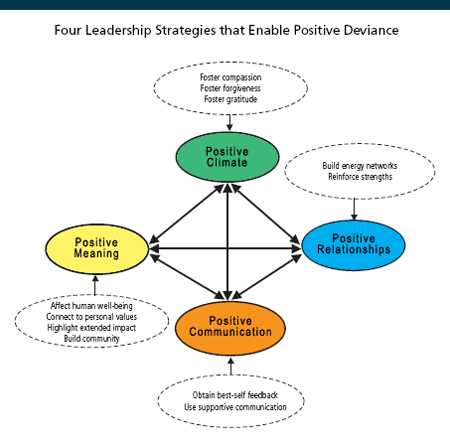 Positive Climate: “Leaders significantly affect organizational climate as they personally induce, develop, and display positive emotions.” Research cited in the book concludes that inducing positive emotions “broaden people’s momentary thought-action repertoires and builds their enduring personal resources.” Conversely, “Negative emotions narrow people’s thought-action repertoires and diminish their coping abilities.” Positive Relationships: People in positive social relationships, “significantly outperformed acquaintance groups on both decision-making and motor tasks.” Interestingly, “Relationships that help people contribute to the benefit of others, rather than merely receive support from them, are the most valuable.” Positive Communication: “The single most important factor in predicting organizational performance—which was more than twice as powerful as any other factor—was the ratio of positive statements to negative statements.” And we’re not talking about 100 to 1 here. Research revealed that the ratio was about 5 to 1 in high-performing organizations. There is a time and place for constructive negative communication. Positive Meaning: “Reinforcing the benefits produced for others, associating work outcomes with the core values of employees, identifying the long-term impact created by the work, and emphasizing contribution goals more than achievement goals all foster a sense of meaningfulness and, as a result, higher levels of performance.” Each chapter ends with a quick assessment of the activities that foster that particular strategy. It will help you identify those areas where you are succeeding and identify areas where you could implement additional behaviors. Also described is a helpful technique for implementing the four strategies called the Personal Management Interview program. The final chapter provides a self-assessment instrument and a guide for implementing the four strategies.Positive Leadership is a short book, but it's long on vital information that a leader in any context would benefit from. While based in empirical research, the ideas presented here will resonate with you. Practiced, they will greatly benefit your corner of the world. 
Posted by Michael McKinney at 08:30 PM
|
BUILD YOUR KNOWLEDGE
 

How to Do Your Start-Up Right STRAIGHT TALK FOR START-UPS 
Grow Your Leadership Skills NEW AND UPCOMING LEADERSHIP BOOKS 
Leadership Minute BITE-SIZE CONCEPTS YOU CAN CHEW ON 
Classic Leadership Books BOOKS TO READ BEFORE YOU LEAD |
|